Failure to account for a building’s construction and fire protection requirements can turn a simple hatch into a hazard
While fire protection often appears to be an active business—with hoses, sprinklers, and extinguishers deployed to fight fires—passive measures, like good building design, often go unnoticed. But when it comes to something as simple as cutting a hole in a wall, there’s a surprising amount at stake.
In this article, we look at the fire and building code governing the use of access panels to help consumers decide when it’s safe and smart to install standard, non-rated drywall access panels—and when it’s necessary to choose a fire-rated panel instead.
If you know everything you need to know about fire-rated and drywall access panels, you can always click here to view our selection of general-use and drywall access panels.
Access panels eliminate the need to cut through walls, ceilings, and floors when interacting with concealed objects
Access panels don’t seem very complicated but like many topics in construction and fire code, there’s more to these simple devices than meets the eye.
Among the most common types of access panels are those designed for installation in ordinary drywall. Made from steel, durable plastic, or other materials, these panels allow installers to conceal unsightly but important spaces. They come in a wide variety of sizes, with some just large enough for an arm and others big enough to permit human entry.
Access panels make it easier to inspect, maintain, and repair critical parts of a building. Instead of slicing through drywall or tile, they facilitate access to plumbing, fire protection piping, electrical components, or other objects in concealed spaces. While most such panels hide openings in interior walls, panels may serve indoor and outdoor walls or ceilings. And many of them arrive ready for paint, allowing installers to minimize any unsightly mismatches between the new assembly and the surrounding structure.
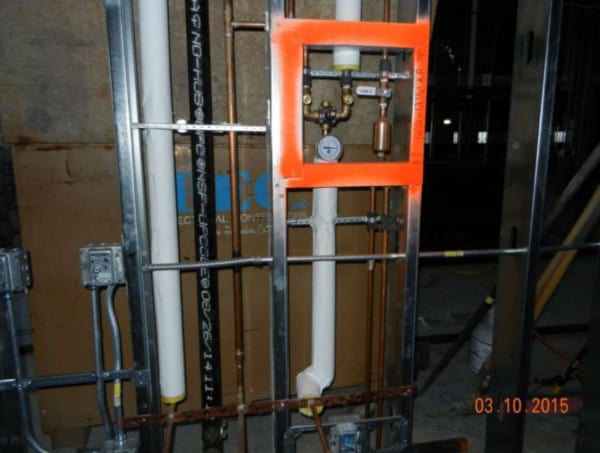
When these panels are used in buildings featuring some measure of fire protection, the codes governing their use often call a panel an “access door” or even “fire door.” Most such doors feature a complete assembly—with a door, hinges, frame, locks, and even insulation or fireproofing material—evaluated for performance against fires. Throughout this article, we stick largely with the more conventional term “access panel,” which sets these objects apart from full-sized doors for entry and exit.
Standards from the National Fire Protection Association govern the characteristics of fire-rated access panels
To figure out which sorts of panels work for a given area, contractors refer to standards from the National Fire Protection Association (NFPA). In NFPA parlance, fixtures designed to cover penetrations in walls—including access panels, fire doors, and other devices—belong to a category of equipment called “opening protectives.” In NFPA 80: Standard for Fire Doors and Other Opening Protectives, access panels in fire-resistant walls, ceilings, and assemblies are called “access doors.”
From the 2019 edition of NFPA 80
3.3.1 Access Door. A door assembly, for installation in fire resistance-rated walls or for installation in ceilings of fire resistance-rated floor-ceiling or roof-ceiling assemblies, that is used to provide access to shafts, chases, attics, spaces above ceilings, or other concealed spaces.
NFPA 80 further divides these access doors into two categories: horizontal access doors, which protect openings in floor-ceiling or roof-ceiling assemblies, and vertical access doors, which protect openings in fire-rated walls.
One core feature of all fire-rated access panels is that they’re designed and tested to withstand exposure to fire and heat. Because an open hole in a wall would allow fire to quickly move from one area to the next—not to mention let heat and smoke escape, delaying smoke detector or fire sprinkler activation—such doors must be self-closing and self-latching.
Independent testing and certification ensure that their design meets the standards of NFPA 80. Specifically, UL-certified access panels (described as “access-type fire doors”) are tested under ANSI/UL 10B when they’re installed in walls, and under ANSI/UL 263 when installed in ceilings or other horizontal assemblies. This testing makes it far more likely that a panel will stop the passage of fire—sometimes for hours, as this video of a UL 10B fire endurance test shows:
The construction type of a building and placement determine a panel’s required fire resistance
Unlike drywall and general-purpose access panels, fire-rated panels are made to slow a fire’s progress between sections of a building (or between adjacent buildings). But different types of structures provide differing degrees of resistance to fire. In turn, these degrees of fire protection dictate just how long a fire-rated panel should last.
In the 2018 edition of NFPA 5000: Building Construction and Safety Code, NFPA classifies buildings according to the types of building materials they employ. The code lists five types of construction, ranging from the most fire-resistant (Type 1) to the least (Type 5):
- Type 1: Fire-Resistive (Concrete and protected steel)
- Type 2: Non-Combustible (Reinforced masonry, tilt slab, and other non-combustible materials)
- Type 3: Ordinary (Non-combustible walls with wood roofs)
- Type 4: Heavy Timber (Older buildings with large dimensional lumber)
- Type 5: Wood-Framed (Walls and roofs made from wood or other combustible materials)
Each of these construction types is typical of certain buildings. Many high-rises and parking garages belong to Type I, which uses structural elements—floors, walls, ceilings, and so on—with limited or no combustibility. New buildings, including newer schools, generally belong to Type 2. Type 3 construction, found in the warehouse districts of some older cities, typically uses brick or block walls. And most modern homes are Type 5 buildings—the most flammable kind.
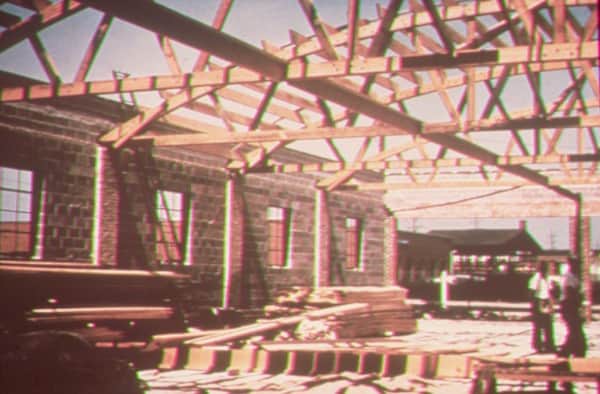
These classifications are further broken into sub-types using a three-digit code. The simplest example might be Type V construction, which can be classified as either combustible (111) or unprotected combustible (000) construction. In NFPA 5000’s construction classifications, each digit stands for the fire protection rating of a structural component in hours:
- First digit: exterior bearing wall rating
- Second digit: frame (column, beam, truss) rating
- Third digit: floor construction rating
Type V (111) has exterior walls, columns, and floors providing one hour of fire resistance each. That’s a sizable contrast with Type V (000) construction—the weakest construction type—which requires no rated fire resistance in any of these essential features.
Walls, frames, ceilings, and floors each have a prescribed minimum level of fire resistance
With an understanding of construction types and sub-types, it’s possible to understand which construction elements are and aren’t designed to resist fire. In table 7.2.1.1, NFPA 5000 prescribes fire resistance ratings to construction elements (walls, columns, and so on) according to a building’s construction type.
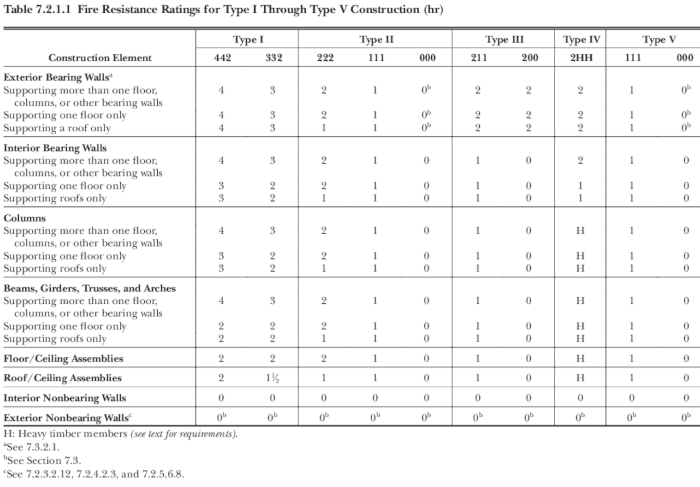
A few things from this table stand out: crucially, walls that don’t hold floor or roof loads (nonbearing walls) don’t have a required fire resistance rating. It’s worth noting that this isn’t the final word on the subject: depending on the building’s purpose (is it a school, or a hospital, or store?), further requirements may be added in other chapters of NFPA 5000. Unprotected wood-framed construction (Type V, 000) has no fire resistance requirements. The same goes for Type II (000)—a category that may be used in some sprinklered hospital buildings of two stories or less.
But when walls, floors, and roofs have a fire-resistance rating, they create protective membranes called fire barriers. These barriers, which prevent the spread of fire from one side of the barrier to another, run continuously from outside wall/ceiling to outside wall/ceiling (or from fire barrier to fire barrier), ensuring that the fire protection they offer isn’t compromised.
From the 2018 edition of NFPA 5000
8.7 Opening Protectives
8.7.1 General. Every opening in a fire barrier shall be protected to limit the spread of fire from one side of the fire barrier to the other.
Know the expected fire resistance of a fire barrier before selecting fire-rated access panels
NFPA 101: Life Safety Code has additional detail on fire barriers, explaining that they require listed opening protectives. Most panels require fire protection ratings detailed in the section on “other fire barriers” in table 8.3.3.2.2 of NFPA 101 (2018 edition):
- 3-hour-rated walls: 3-hour-rated panel assemblies
- 2-hour-rated walls: 1 1/2-hour-rated panel assemblies
- 1-hour-rated walls: 3/4-hour-rated panel assemblies
- 1/2-hour-rated walls: 1/3-hour-rated panel assemblies
As a general rule, access panels with fire protection ratings equal to the fire resistance ratings of their surrounding barrier can safely ensure that the entire barrier remains intact. And in most cases, panels and other opening protectives can offer slightly less protection the barrier itself. However, not all fire barriers follow the pattern listed above. Table 8.3.2.2 of NFPA 101 lists a different set of required ratings for protective openings serving specific kinds of barriers, including those guarding:
- Elevator hoistways
- Elevator lobbies
- Vertical shafts
- Replacement panels in existing vertical shafts
- Horizontal exits
- Horizontal exits served by bridges between buildings
- Exit access corridors
- Smoke barriers
- Smoke partitions
By putting this information together, it’s clear that most construction types feature fire-rated walls, ceilings, floors, and structural supports, and that access panels installed in those walls should offer anywhere from 1/3 to 3 hours of fire protection.
But in some types of construction—and in non-load-bearing walls in other construction—drywall access panels and other non-rated fire doors can be used. Again, it’s important to carefully consider the building’s materials and the fire ratings of construction elements before making a selection.
Some drywall and other non-rated access panels are more versatile than others
Senju Sprinkler, Japan’s largest manufacturer of fire sprinkler components, has developed universal access panels suitable for installation in drywall, masonry, tile, and other surfaces. Their doors—made from either galvanized steel or impact-resistant ABS plastic—install on walls or ceilings to provide non-fire-rated concealment of plumbing, piping, and other devices best left out of sight.
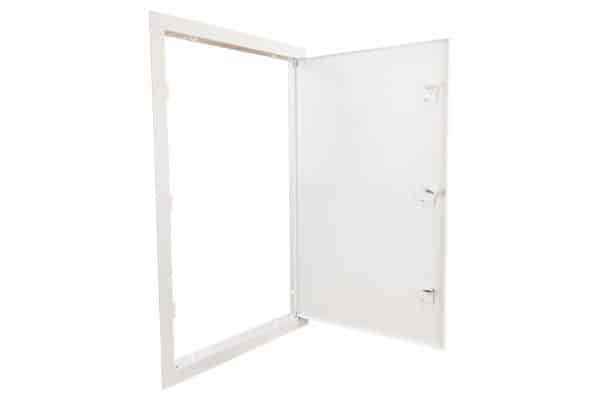
QRFS stocks Senju’s general-use access panels online, including a 14″ x 24″ white-finished steel panel and a 14″ x 14″ paintable ABS plastic panel with snap latches, for use in non-fire-rated applications. For more information and pricing, click here to view our selection of general-use and drywall access panels.
If you need to buy fire-rated access panels for areas that require a higher level of protection, or you have questions about sizes or specs, give us a call at (888) 361-6662 or email support@qrfs.com.
This blog was originally posted at blog.qrfs.com. If this article helped you understand which kinds of access panels you needed, check us out at Facebook.com/QuickResponseFireSupply or on Twitter @QuickResponseFS.


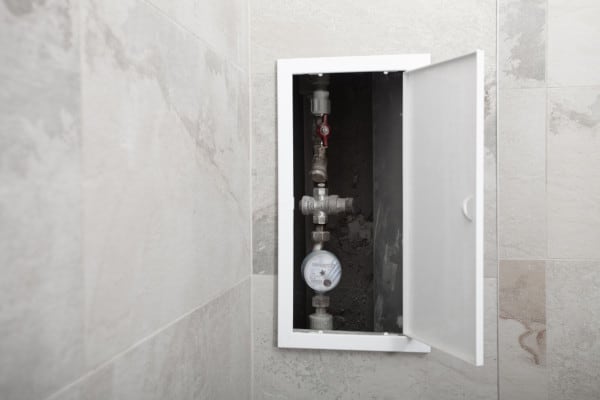
This is a very detailed writeup, thank you for sharing this content!
Every step of the construction and installation process must take code requirements into account. Excellent explanation, it’s simple & focus. Keep up the great work!